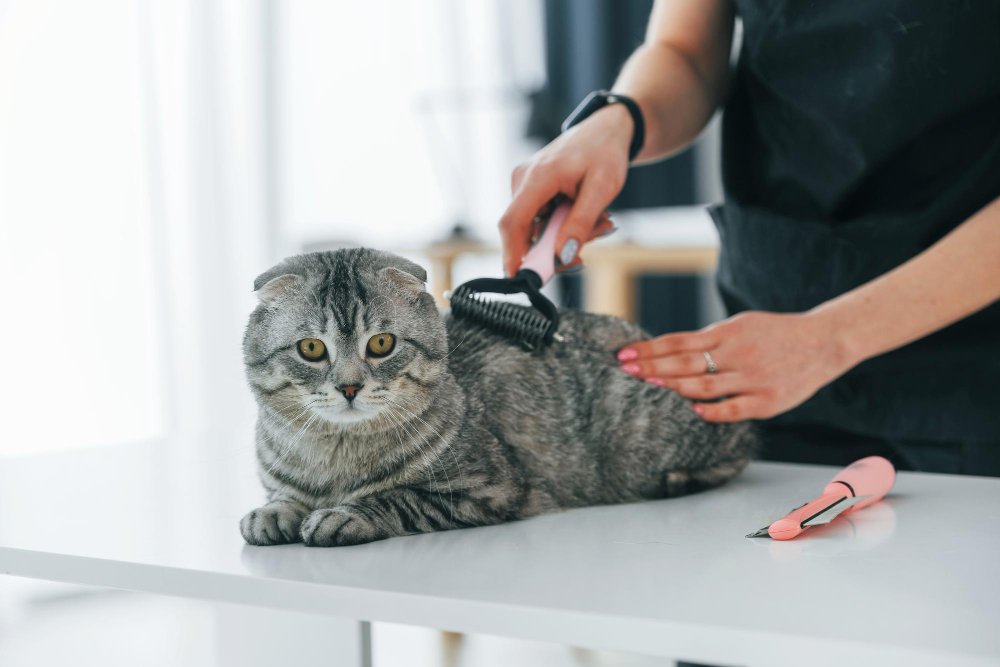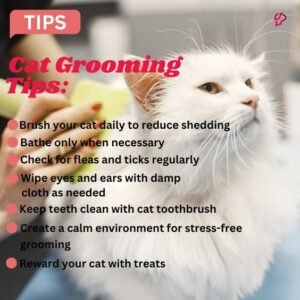Are tangles and knots in your cat’s fur causing grooming challenges? You’re not alone. This article delves into practical detangling solutions for optimal cat fur care. We’ll introduce you to specialized brushes, detangling sprays, and easy-to-follow techniques designed to transform grooming from a chore into a pleasant experience. Say farewell to frustrating tangles and welcome a world of smooth, silky fur for your cherished feline companion.
Understanding Tangles and Knots in Cats
We all love our furry feline friends, but sometimes their fur can become a tangled mess. Understanding the causes and effects of tangles and knots in cats is crucial in keeping their coat healthy and comfortable.
Causes of tangles and knots
Tangles and knots can occur in a cat’s fur for several reasons. One common cause is inadequate grooming. Cats, especially long-haired breeds, require regular brushing and combing to prevent tangles from forming. Additionally, shedding can contribute to tangles as loose hair gets caught and intertwined with the existing fur. Outdoor cats are also more prone to tangles due to exposure to elements like wind and dirt.
Effects of tangles and knots on cats
Tangles and knots can be more than just an aesthetic issue. They can cause discomfort and pain for your beloved feline companion. When left untreated, tangles can pull on the skin, leading to irritation and even sores. Cats may also experience difficulty in movement, especially if tangles form near their joints or armpits. The presence of tangles can also impact a cat’s ability to regulate body temperature, leading to overheating or cold intolerance.
Importance of regular grooming to prevent tangles and knots
Regular grooming is key to preventing tangles and knots in your cat’s fur. By establishing a grooming routine, you can keep their coat healthy and free from tangles. Regular brushing and combing helps remove loose hair and prevents matting. It is essential to choose the right tools and grooming products to effectively manage your cat’s fur.
Choosing the Right Tools for Detangling
Detangling your cat’s fur requires the right tools to make the process easier and more effective. Here are some considerations when selecting tools for detangling:
Combs and brushes for detangling
Different combs and brushes serve specific purposes when it comes to detangling. For tangles closer to the skin, a wide-toothed comb is ideal as it can gently tease out the knots without causing discomfort. Slicker brushes are great for removing loose hair and preventing tangles from forming. Bristle brushes, on the other hand, are useful for smoothing and distributing natural oils in the coat.
Types of grooming products to consider
In addition to combs and brushes, there are grooming products specifically designed to aid in detangling. Detangling sprays can be used to soften knots and make them easier to remove. Conditioning shampoos and leave-in conditioners can also help keep the fur soft and manageable.
Considering the cat’s coat type when selecting tools
It’s important to consider your cat’s specific coat type when choosing detangling tools. Long-haired cats may require brushes with longer bristles to reach the undercoat effectively. For short-haired cats, a rubber grooming tool can be useful in removing loose hair and preventing tangles. Understanding your cat’s coat type will ensure you select the most appropriate tools for detangling.
Preventing Tangles and Knots
Prevention is always better than cure, especially when it comes to tangles and knots in your cat’s fur. Here are some preventive measures you can take to keep their coat tangle-free:
Regular brushing and combing
The most effective way to prevent tangles is to establish a regular brushing and combing routine. This helps in removing loose hair and preventing it from combining with the existing fur. It is best to start grooming your cat from a young age to get them accustomed to the process. Long-haired cats may require daily brushing, while short-haired cats may only need grooming sessions a few times a week.
Using specialized detangling sprays
Detangling sprays can be a helpful addition to your grooming routine. These sprays work by softening the knots and making them easier to comb out. It’s important to choose a detangling spray specifically formulated for cats to ensure it is safe for their fur and skin.
Trimming and maintaining the cat’s fur
Regular trimming of your cat’s fur can also prevent tangles from forming. This is especially important for long-haired breeds. Trimming the fur around areas prone to tangles, such as the armpits and behind the ears, can minimize the risk of matting. Additionally, maintaining a healthy diet and ensuring your cat is hydrated can contribute to the overall health of their coat.
Effective Techniques for Detangling
Detangling your cat’s fur requires patience, gentleness, and the right techniques. Here are some tips for effective detangling:
Working slowly and gently
When dealing with tangles, it’s crucial to work slowly and gently to avoid causing any discomfort or pain for your cat. Start by using your fingers to loosen the knots, and then proceed with a comb or brush. If the tangle is particularly stubborn, avoid pulling at it forcefully, as this may result in hair breakage or skin irritation.
Using appropriate detangling techniques
Different techniques can be employed based on the severity of the tangles. For minor tangles, gently comb through the fur in small sections, starting from the bottom and working your way up. Use short strokes and be mindful of any resistance. For larger knots, it may be necessary to carefully cut them out using blunt-nosed scissors. Always exercise caution when using scissors near your cat to prevent accidental injury.
Handling sensitive areas with care
Certain areas of your cat’s body may be more sensitive to detangling. Take extra care around the ears, tail, and belly, as these areas can be susceptible to tangles. Using a detangling spray or a small amount of conditioner can help minimize discomfort in these sensitive areas.
Professional Grooming Services
While grooming your cat at home is possible, sometimes seeking professional grooming services can provide additional benefits. Here’s why professional grooming is advantageous:
Benefits of professional grooming
Professional groomers have the expertise and experience to handle all types of coats and detangling challenges. They are equipped with specialized tools and grooming products to effectively remove tangles and knots. Professional grooming can also serve as a preventive measure, as groomers are trained to identify potential skin and coat issues before they become more severe.
Finding a reputable groomer
When choosing a professional groomer, it’s important to do your research and find a reputable one. Ask for recommendations from friends, family, or your veterinarian. Look for groomers who prioritize the well-being and comfort of the cats in their care. Visiting the grooming facility beforehand can also help you assess their cleanliness and professionalism.
What to expect during a grooming session
During a grooming session, your cat will undergo a thorough assessment of their coat and overall health. The groomer will discuss any specific concerns or issues you may have. They will then proceed with the necessary grooming procedures, such as brushing, combing, and detangling. Depending on the condition of your cat’s coat, additional services, such as bathing and trimming, may be recommended.
Home Remedies for Detangling
If you prefer a more natural approach to detangling your cat’s fur, there are home remedies that can be effective. Here are some options to consider:
Natural oils and conditioners for detangling
Certain natural oils and conditioners, such as coconut oil or argan oil, can help detangle your cat’s fur. Apply a small amount to your hands and gently work it through the tangles. The oil acts as a lubricant, making the knots easier to remove. However, it’s essential to ensure the oil or conditioner used is safe for cats and does not contain any harmful ingredients.
DIY detangling solutions using household items
You can also create your own detangling solution using household items. A mixture of warm water and apple cider vinegar can be used as a detangling spray. Simply spray it onto the tangles and gently comb through the fur. Additionally, a mixture of water and a small amount of liquid fabric softener can act as a detangler. Ensure the fabric softener used is pet-safe and diluted properly.
Cautionary measures to consider
While home remedies can be beneficial, it’s crucial to exercise caution. Test any new products or solutions on a small area of your cat’s fur first to ensure there are no adverse reactions. Avoid using any ingredients that may be toxic to cats, such as essential oils or strong cleaning agents. If you notice any signs of discomfort or allergic reactions, discontinue use immediately and consult with a veterinarian.
Dealing with Severe Tangles and Knots
In some cases, tangles and knots may become severe and require additional measures. Here’s what you should do when dealing with severe tangles:
When to seek veterinary assistance
If you notice severe tangles or knots that you are unable to detangle yourself, it may be necessary to seek veterinary assistance. Veterinarians have the knowledge and tools to handle difficult detangling situations. They can also determine if there are any underlying health issues causing the tangles and provide appropriate treatment.
Sedation options for detangling procedures
Detangling severely matted fur may require sedation to ensure the comfort and safety of your cat. Sedation allows veterinarians to work more effectively and minimizes stress for the cat. Discuss with your veterinarian the best sedation options for your cat based on their health and the severity of the tangles.
Preventing future tangles and knots
Once severe tangles have been addressed, it’s important to take steps to prevent them from occurring again in the future. Regular grooming, as well as adjusting your cat’s diet and hydration levels, can help maintain a healthy coat. Taking preventative measures will ensure that your cat’s fur remains tangle-free and easy to manage.
Safe and Stress-Free Detangling Methods
Detangling can be a stressful experience for cats, so it’s essential to create a safe and comfortable environment. Here are some tips to make the detangling process as stress-free as possible:
Preventing cat anxiety during detangling
Cats can become anxious during grooming sessions, especially if they have had negative experiences in the past. To minimize anxiety, create a calm and quiet environment for detangling. Set up a designated grooming area with minimal distractions. It can also help to play soothing music or use pheromone sprays designed to reduce stress in cats.
Using positive reinforcement techniques
Positive reinforcement techniques can help your cat associate grooming with positive experiences. Offer treats or rewards during and after the detangling process, praising your cat for their cooperation. This can create a positive association with grooming and make future sessions more pleasant for both you and your cat.
Creating a calm and comfortable environment
Make sure your cat is comfortable before starting the detangling process. Ensure they are relaxed and not hungry or agitated. Gently stroke and pet your cat to help them relax further. Using a soft towel or blanket to provide a cozy surface can also help create a sense of comfort and security for your cat.
Specific Detangling Challenges: Long-Haired Cats
Long-haired cats require extra care and attention when it comes to detangling. Here are some specific challenges to consider:
Care considerations for long-haired breeds
Long-haired breeds, such as Persians or Maine Coons, have fur that is more prone to tangling and matting. These cats may require daily brushing or combing to prevent tangles from forming. Regular trimming of the fur around the hindquarters and tail can also help reduce the risk of matting.
Specialized tools and techniques for long-haired cats
When detangling long-haired cats, specialized tools can be extremely helpful. Long-toothed combs or detangling brushes with gentle bristles can help navigate through their thick coats. Sectioning the fur and working through small sections at a time can make the process more manageable. If you are unsure about the best tools and techniques for your cat’s specific breed, consult with a professional groomer or your veterinarian.
Potential health issues associated with long hair
Long-haired cats are more susceptible to certain health issues related to their fur. The presence of tangles and mats can create a breeding ground for parasites, such as fleas or ticks. Additionally, cats with long hair may be more prone to hairballs, which can cause digestive issues if left untreated. Regular grooming and detangling are essential in preventing these health issues and maintaining optimal well-being for your long-haired cat.
Specific Detangling Challenges: Senior Cats
Senior cats may present unique challenges when it comes to detangling due to age-related coat changes. Here are some considerations for detangling senior cats:
Age-related coat changes and tangles
As cats age, their fur may undergo changes, becoming coarser and prone to tangles. Senior cats may develop more brittle hair, making it easier for knots to form. Pay close attention to your senior cat’s coat and address any tangles promptly to prevent them from worsening. Adjusting your grooming routine to suit their changing needs is key to keeping their coat healthy and comfortable.
Adjusting grooming routines for senior cats
Grooming senior cats may require more gentleness and care due to their age-related sensitivities. Take extra precautions when detangling their fur, working slowly and using less force. Be mindful of any discomfort your senior cat may experience and make adjustments accordingly. Using softer, more cushioned brushes or combs can also provide a more comfortable grooming experience for older cats.
Assisting senior cats with grooming
Some senior cats may have difficulty grooming themselves due to mobility issues or arthritis. It’s important to assist them by gently brushing and detangling their fur. Regularly checking for tangles and knots and addressing them promptly can help prevent discomfort and matting. If your senior cat is experiencing difficulty grooming, consult with your veterinarian for additional guidance and support.
Taking the time to understand and address tangles and knots in your cat’s fur is essential for their overall well-being. By implementing regular grooming routines, using appropriate tools and techniques, and seeking professional assistance when needed, you can ensure that your cat’s coat remains tangle-free and healthy. With patience, care, and a little extra attention, you and your feline friend can enjoy a stress-free detangling experience.


